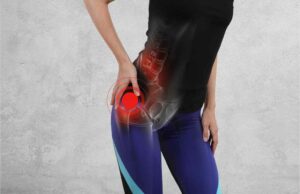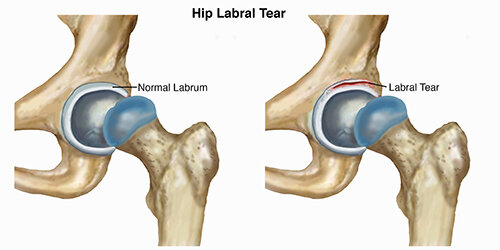If you are experiencing pain in your hip, you may be wondering what is wrong. One possible cause of hip pain is a labral tear. A labral tear is a tear in the cartilage that circles the edge of the hip socket. This type of injury can be very painful and can make it difficult to move your hip. In this blog post, we will discuss the symptoms and treatment options for labral tears in the hip.
Contents
What is a Labral Tear in the Hip?

A labral tear is a tear of the cartilage that lines the edge of the hip socket. This can be caused by repetitive motion, trauma, or degeneration. It is a relatively common injury, especially in athletes. Labral tears can occur in any population, but they’re most common in people who play high-impact sports, such as hockey, football, or soccer. You’re also more likely to have a labral tear if you’ve had a previous hip injury.
It is a common injury that can occur in the hip joint. The labrum is a piece of cartilage that helps to stabilize the hip joint and keep the ball of the femur (thighbone) in place within the socket. A tear can occur when there is a sudden impact or force exerted on the hip joint, such as during a fall or car accident. It can also occur gradually over time due to wear and tear.
Signs And Symptoms
There are various signs and symptoms. It will be included as follows:
Location: You will feel the pain in the groin, outer thigh, buttocks, or even lower back. For instance, you will feel pain when you lift your leg to step up or when you rotate your hip.
Onset: The pain might come on gradually or suddenly. It also might get worse with certain activities, such as running, sitting for long periods, or climbing stairs. For instance, you might feel pain when you:
Intensity: The pain can range from mild to severe and can be aggravated by activities such as running, jumping, or squatting. For instance, you may feel pain when trying to rotate your hip or when bearing weight on the affected side.
So these are the symptoms of a labral tear in your hip.
Causes

Labral tears can be caused by repetitive motions or a single injury. It includes as follows:
Repetitive motions
Activities such as soccer, tennis, or golf that require repeated hip rotation can lead to a labral tear. For instance, the motion of swinging a golf club can place significant stress on the hip joint and lead to a tear.
Acute injuries
A direct blow to the side of the hip or a fall can cause the labral tissue to tear. For instance, you may suffer a labral tear if you experience a hard tackle while playing football. For example, you may suffer a labral tear if you experience a hard tackle while playing football.
Chronic injuries
Chronic injuries are usually the result of overuse, such as from repetitive motions during sports activities. These motions can put stress on the joint, leading to small tears in the labral tissue that can eventually worsen over time. For example, people who participate in sports that require a lot of hip rotation, such as baseball, golf, or tennis, may be more likely to develop a labral tear.
Risk factors
Several risk factors may increase your chances of developing a labral tear, including:
Age
The risk of developing a labral tear increases with age. This is because the cartilage in the hip joint wears down over time, making it more susceptible to injury. For instance, a study published in the American Journal of Sports Medicine found that labral tears were more common in people over the age of 40.
Gender
Women are more likely to develop a labral tear than men. This may be due to hormonal changes, such as during pregnancy, which can make the hip joint laxer. Additionally, women tend to have narrower hips, which can contribute to greater wear and tear on the joint over time.
Sex
Females are more likely to develop a labral tear than males. This may be due to hormonal changes or differences in anatomy. For instance, females tend to have narrower hips and shallower hip sockets than males. This may predispose the labral tissue to injury.
Family history
If you have a family member with a history of hip problems, you may be more likely to develop a labral tear. For instance, if your parents or grandparents had hip dysplasia (a condition in which the ball-and-socket joint is malformed), you may be more likely to develop a labral tear.
Certain activities
Activities that require you to repeatedly twist or rotate your hips, such as golf or ballet, can put you at risk for a labral tear. Individuals who participate in high-impact activities or sports are more susceptible to developing a labral tear.
Certain medical conditions
Certain medical conditions, such as rheumatoid arthritis, can increase your risk of developing a labral tear. For instance, rheumatoid arthritis is a condition that causes inflammation in the joints. When this type of arthritis affects the hip, it can damage the labrum. For example, the inflammation associated with rheumatoid arthritis can cause the labrum to become weakened. This, in turn, may make it more susceptible to tearing.
Other risk factors for developing a labral tear include:
- Dislocation or subluxation of the hip
- Bone marrow edema
- Femoroacetabular impingement (FAI)
- Labral hypertrophy
These conditions can all lead to a tear in the labrum. Dislocation or subluxation of the hip occurs when the ball portion of the joint is no longer centered in the socket. This can cause the labrum to tear.
Bone marrow edema is a condition in which there is abnormal swelling in the bone marrow. This can put pressure on the labrum and lead to a tear.
FAI occurs when there is too much contact between the ball and the socket of the hip joint. This can damage the labrum and lead to a tear. Labral hypertrophy is a condition in which the labrum becomes thickened or enlarged. This can also cause the labrum to tear.
Diagnosis
There are several different types of diagnosis. This will include:
Clinical Examination
The first step is to take a thorough history of your symptoms and perform a physical examination. Your doctor will check for signs of hip instability, such as pain with range of motion testing may also be done.
Imaging Tests
The next step is to get imaging tests of your hip. This usually includes an X-ray, MRI, and/or CT scan. These can help to rule out other causes of your pain and to assess the severity of your injury. For instance, an MRI can show whether you have a complete or partial tear of your labrum. It can also show how much damage there is to the surrounding structures, such as the bone or cartilage.
Diagnostic Arthroscopy
This is a minimally invasive procedure that is used to directly visualize the hip joint. A small camera is inserted into the joint through a tiny incision. This can help to confirm the diagnosis and to assess the extent of the injury.
Other Specialized Testing
In some cases, other tests may be needed. This can include blood tests, genetic testing, or a biopsy. These are usually only done if other causes of your symptoms are being ruled out. For instance, if your doctor suspects you may have arthritis, they may order a blood test to look for inflammatory markers. If an infection is suspected, a joint aspiration may be done. This involves numbing the area and then drawing out a small amount of fluid from the joint with a needle for testing. In some cases, imaging tests like x-rays or an MRI may also be ordered.
Thus these other tests may be needed if the doctor is still unsure about what’s causing your symptoms even after taking your medical history and doing a physical exam. But don’t worry, these tests are usually not painful and can help give your doctor the answers they need to make a diagnosis.
If you think you have a labral tear, it’s important to see your doctor. They will ask about your symptoms and medical history. They will also do a physical exam. An MRI or CT scan may be needed to confirm the diagnosis.
Treatment Options
The Treatment options are as follows:
Surgery
This is the most common treatment option for a labral tear in the hip. The surgery involves repairing the tear and reattaching the labrum to the bone. For instance, if the tear is small, the surgeon may just sew it back together. If the tear is large, the surgeon may need to use a piece of tissue to patch it up.
Physical Therapy
Physical therapy can help to strengthen the muscles around the hip and improve the range of motion. For instance, exercises that stretch the iliopsoas muscle, which is located in the front of the hip, can be helpful. Your physical therapist can also teach you how to properly perform activities such as squatting and lifting to help prevent further injury to your hip.
Steroid Injections
Steroid injections can help to reduce pain and inflammation. For example, a 2016 study found that intra-articular corticosteroid injections were effective in reducing pain for up to six months in people with hip joint OA.4 However, it’s important to note that steroid injections are not a cure for hip joint OA and they may only provide temporary relief.
Anti-inflammatory Medications
These medications can help to reduce pain and inflammation. For instance, your doctor may recommend over-the-counter (OTC) anti-inflammatory medications, such as ibuprofen or naproxen. If these don’t help, they may prescribe stronger medications, such as corticosteroids.
Rest and Ice
Rest and ice can help to reduce pain and inflammation. For instance, you might want to take a few days off from your regular activities. You can also put ice on the affected area for 20 minutes at a time, several times a day.
So, these are some of the treatment options for a labral tear in the hip. If you think you may have this condition, be sure to see your doctor so they can give you a proper diagnosis and create a treatment plan that is right for you.
Conclusion
It may be concluded that a labral tear in the hip can lead to significant problems and should be treated carefully. The problems are not only restricted to pain but also may affect the individual’s quality of life. Early diagnosis and proper treatment are essential to preventing long-term complications.
If you think you may have a labral tear in your hip, it is important to consult your doctor to get an accurate diagnosis and determine the best course of treatment.
Physical Therapy help patients recover from pain. If you’re experiencing Back pain, Shoulder pain, Knee pain, Neck pain, Elbow pain, Hip pain, or Arthritis pain, a physical therapist at MantraCare can help: Book a physiotherapy session.


